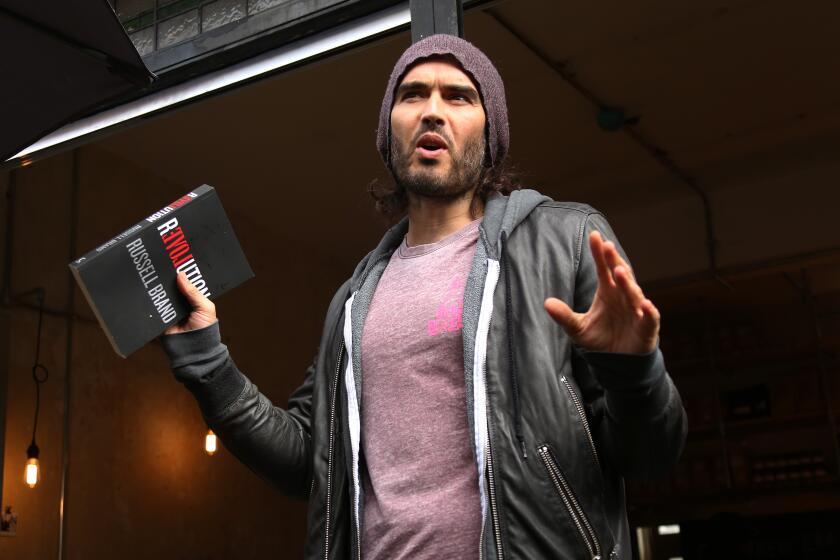The networks’ have a big rival at 10 p.m.: Their earlier shows on DVR
Not so long ago, the broadcast networks trumpeted their 10 p.m. shows as “appointment viewing,” an hour so named for its slate of sophisticated and stylish dramas that commanded a rapt audience who watched in real time.
Today, audiences are still watching at 10 p.m., but often not what the networks programmed for that time slot. Instead, people are increasingly playing back recorded shows from their digital video recorders.
“Essentially the DVR has been like adding a whole new competitor to the time period,” said David Poltrack, CBS’ chief research officer. “The new competitor is often our own programming.”
Next week, the broadcast networks plan to unveil their new fall schedules during flashy presentations for hundreds of advertisers in New York. Television’s spring ritual, known as the “upfronts,” is important for the industry because it kicks off the annual sale of commercial time. And for ABC, CBS and NBC, improving on their 10 p.m. performances during the upcoming season is a priority.
But the challenges are great.
More than 36% of all TV households now are equipped with a DVR, accelerating shifts in viewing patterns. At 10 p.m., nearly 6 million viewers are watching previously recorded shows, according to ratings firm Nielsen Co. On Friday night, for example, as many people are watching recorded shows as the top program in the time period, “Numb3rs” on CBS, Poltrack said.
Meanwhile, cable channels have continued their incursion into broadcasters’ traditional turf by running their own original dramas at 10. Broadcasters have made missteps too. The hour has become a graveyard for ambitious but failed efforts during the last few seasons, including ABC’s “Eli Stone” and “Life on Mars,” CBS’ “Harper’s Island” and “ Eleventh Hour,” and NBC’s “ My Own Worst Enemy.”
The peacock network’s problems were compounded by its recent disastrous experiment with Jay Leno in a prime-time show. NBC on Friday also canceled the original “Law & Order” program, once the titan of 10 o’clock, because of dwindling audiences. NBC’s ratings are down 27% at 10 p.m. compared with last season among advertisers’ favorite demographic, 18-to-49-year-old viewers.
“We have learned that you have to put your best stuff on at 10 p.m. if you want to compete. Websites, cable channels, DVRs — they are all vying for people’s attention,” said Jeff Gaspin, chairman of NBC Universal Television Entertainment.
NBC executives a year ago predicted that a Leno show with topical humor would be “DVR-proof” because audiences would be inclined to watch in real time. In fact, the DVR was a far more popular viewing option than the comedian. Since NBC shuffled Leno back to late night, ratings at 10 p.m. have increased by 40%, Gaspin said.
At 10 p.m., ratings for ABC are down 11% compared with the 2008-2009 TV season, and CBS is off 3%.
“It is getting harder and harder to get a hit at 10 o’clock,” said Brad Adgate, research director for the advertising buying firm Horizon Media. The depressed ratings are “not quite where Friday and Saturday nights are, but not that far away,” Adgate said.
Television researchers have detected a pattern. DVR use is heavy throughout the night. But because competition on the networks is particularly fierce at 9 p.m., when Fox and the CW are running new episodes, 10 p.m. has become the hour when people catch up on their second-favorite 9 p.m. show — a trend that leaves fewer viewers to watch the shows in real time.
“The 9 o’clock shows are more likely to be played the same night,” said Poltrack. “The 10 o’clock shows get pushed back, out of that viewing window. People often don’t watch those shows the same night.”
Alan Wurtzel, NBC Universal’s president of research and media development, said the use of DVRs “puts additional pressure on programs to be compelling. Now shows also have to compete with a disc full of shows that are, by definition, people’s favorites.”
Still, the TV executives say, the effects of digital recorders haven’t been all bad.
“The DVR is kind of a frenemy,” said Wurtzel. “It throws up into the air 50 years of established behavior when we didn’t have the ability to fast-forward through commercials. But DVRs also extend the reach and the audience for many of our shows.”
Overall, DVR playbacks have dramatically increased the audience for certain shows, including “Grey’s Anatomy” on ABC, “The Mentalist” on CBS and “Vampire Diaries” on the CW. Digital recorders tend to give the biggest lift to the most popular shows and those with younger-skewing audiences.
“Big shows get even bigger,” Poltrack said. And the weaker shows get hurt.
The 10 p.m. hour is of particular importance to the networks and their TV stations because it serves as a funnel or lead-in to their local news.
This fall, there will most likely be more new shows on at 10 p.m. than in any other time slot. NBC plans to order about nine new dramas, and several are in contention for slots at 10, including “Chase,” from Jerry Bruckheimer about U.S. Marshals, “Undercovers,” a spy drama from J.J. Abrams, a “Law & Order” spinoff set in Los Angeles and a remake of “The Rockford Files.” The network has already said it is bringing back its Tuesday 10 p.m. drama “Parenthood.”
ABC also will likely have several new shows on at 10 p.m. Programs in development for that hour include “Detroit 187,” a police drama done in documentary style starring Michael Imperioli from “The Sopranos”; “Body of Proof,” a medical drama; and “Matadors,” a prime-time soap opera about two rival families whose cast includes David Strathairn and Zach Gilford.
CBS, which has fewer holes to fill in that hour, has a couple of high-profile projects that could end up on the air, including a remake of “ Hawaii Five-O,” a spinoff of “Criminal Minds” and a legal drama called “The Defenders” about Las Vegas lawyers.
More to Read
The biggest entertainment stories
Get our big stories about Hollywood, film, television, music, arts, culture and more right in your inbox as soon as they publish.
You may occasionally receive promotional content from the Los Angeles Times.







